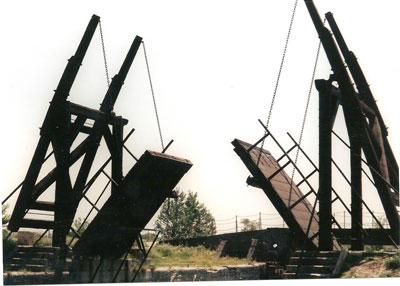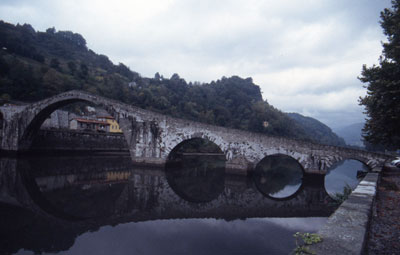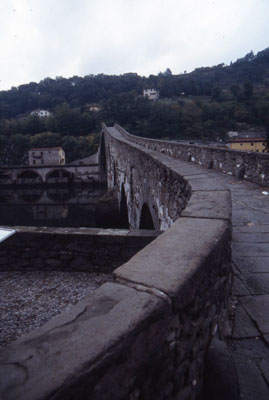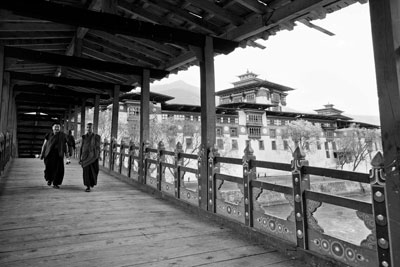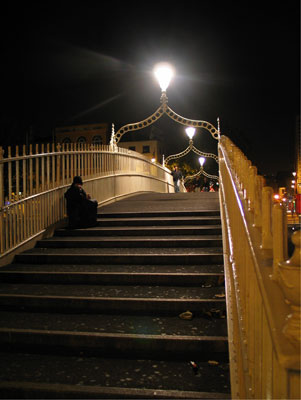Cross that bridge
We gave you this assignment: name a bridge (outside of the USA) that, for whatever reasons, is exciting to cross. Tell where it is (and, if necessary, how to find it) and approximately when you were there. Did you cross it on foot? By car? By train? Include your impressions. You may write about more than one bridge.
We printed a few responses (March and April ’10 issues). Here are a few more, with more to come. If you have one to add, write to Cross That Bridge, c/o ITN, 2116 28th St., Sacramento, CA 95818, or e-mail editor@intltravelnews.com (include the address at which you receive ITN). With photos, include captions.
Finding Vincent van Gogh’s famous painting “The Langlois Bridge at Arles” is easy. You just go to the Van Gogh Museum in Amsterdam, where one version of it is prominently displayed. (Van Gogh painted several views of it.) Finding the bridge, itself, is another matter, and crossing it is impossible because it is permanently open, but we got as close as you can.
A print of the famous painting is displayed in the dining room of some friends of ours, so on a trip to Provence in 2005 we were determined to find the bridge. The original bridge was destroyed by fire in 1926; however, it was reconstructed some four kilometers south of Arles, slightly nearer to the city than the original.
Surprisingly, the bridge was not identified on any of a number of tourist maps we had. The tourist information office in Arles was only somewhat helpful, directing us south on the D-35 but unclear on exactly where to find the bridge. We watched closely on our left, the river side of the bridge, but soon found ourselves on the way to Port-Saint-Louis. Obviously, we had gone too far. We stopped at several commercial establishments asking for directions but to no avail.
Then we spotted an Ernest Hemingway look-alike smoking a pipe on a bench, and he advised us to head back toward Arles and watch for a small wooden sign that would direct us toward the river. Sure enough, the sign, which was not visible heading south, could be spotted when looking carefully heading north.
Some 20 yards off the road we found the bridge. It’s a tiny drawbridge, and the two pieces comprising its center are frozen in the upward position. To the left of the bridge was a large poster showing the painting and giving a brief history.
We spent 20 minutes at the bridge, enjoying the idyllic scene and taking pictures. The mood was broken when a tourist bus pulled up and unloaded some 40 chattering, picture-taking Japanese tourists — apropos, however, as van Gogh originally titled his painting “The Japanese Langlois Bridge in Arles” because of its very Nipponese design.
Fred Steinberg
Riverside, CA
In Borgo a Mozzano, Italy, 14 miles northeast of Lucca, there is a most unusual and beautiful bridge. Built in the 12th century, it crosses the River Serchio.
Its official name is Ponte della Maddalena. However, legend says the builder was having trouble getting it built, so he enlisted the help of the devil. The devil’s price for his help was the soul of the first one to cross the bridge. The builder tricked the devil by sending not a person but a dog across! So it’s also called the Ponte del Diavolo (Devil’s Bridge).
After three delightful days in Lucca in October ’06 and before motoring on to Portovenere, my wife, Elissa, and I took this little side trip (about 30 minutes by car — off of the A11 near Lucca, take the SS12 in the direction of Abetone, then follow the road).
The setting and design of the bridge are outstanding. We walked over it for the view plus the feel of the 800-year-old stones under our feet.
The bridge is deceptive. When you first look at it, you don’t realize how steep it is and how far it is to the middle.
Richard Finerman
Palm Springs, CA
The Lethbridge Viaduct, a rail bridge in Alberta, Canada, is really a sight to see when the long freight trains cover its entire span. About 300 feet high and more than a mile long, it was built over the Oldman River in 1909.
I’ve been under it and photographed it from many angles, most recently in 2001. Wow!
There’s a park and campground close by.
Ingel Wilson
Alamogordo, NM
Having led 14 photography tours to Bhutan, most recently in October ’09, I’ve crossed the covered wooden bridge over the Mo Chhu (Female River) in central Punakha many times. At 180 feet in length, it is the world’s longest unsupported bridge using cantilever design.
The bridge leads to Punakha Dzong, which was built in 1637 as a fortress castle to defend against Tibetan invaders. Now considered the most sacred and important dzong in all of Bhutan, it is comparable in importance to the Vatican because this ancient holy place is now the winter residence of His Holiness the Chief Abbot and of 500 monks and lamas who comprise the Monk Body.
The bridge, originally built in 1637, was washed away by a glacial flood in 1958. Originally, it measured 35 meters in length, but the flood widened the river, so modern engineers had the daunting task of widening the bridge to 55 meters.
The government of Bhutan wanted to replicate the original bridge, but there were no drawings or plans, so they had to go by old photographs — quite a task for modern engineers. Steel girders were hidden within the wooden framework of the bridge, making it a mix of medieval traditional design and modern technology.
Mr. Robin Smillie
Tampa, FL
My husband, Jerry, and I went to New Zealand a number of years ago primarily to hike the Milford Track. On the way to Queenstown we stopped at Mt. Cook Alpine Lodge for a night and took a hike in the vicinity.
After a short while we encountered a swinging footbridge. We would have to cross this bridge, which spanned a very deep river chasm, in order to continue the hike. We decided to overcome our fears and cross the river (but one at a time, to minimize the swing).
We were very happy we did so because the hike was wonderful. And when, subsequently, we encountered swinging bridges on the Milford Track, we crossed them with panache.
Nili Olay
New York, NY
My wife, Sara, and I arrived in Dublin, Ireland, late one afternoon in October ’03. Our first visit to the Temple Bar area was for dinner and to take a pub tour. The completion of the tour left us next to the Ha’penny Bridge, which spans the Liffey.
At night, the arched walking bridge is lit by evenly spaced lamps. Sitting under one of the lamps was a woman with a paper bag. It brought to mind a vision of Eliza Doolittle from “My Fair Lady.”
The picture I took brings back the feeling we had that night every time we look at it.
Davis Harris
Silver Spring, MD
In the Pyrénées of southern France, near the Spanish border, there’s a footbridge in the Tech River Valley where, before walking on it, helmets are provided and wearing them is required.
In the Gorges de la Fou, you walk on a twisting and turning metal footbridge in a crevice cut by the rushing water below. The footbridge through the slot canyon is almost a mile long, ending at a platform with a spectacular view where the gorge opens up.
The walkway is about four feet wide, with waist-high side railings and some stairs. The gorge is so narrow in some places that you can reach out and touch both walls. Wire mesh above the bridge provides a defense against falling rocks.
Gorges de la Fou is located west of Arles-sur-Tech, just off the D115. We visited in September ’09 as a day trip from Céret, which was an excellent base for seeing the region.
The gorge is open daily 10 a.m. to 6 p.m., April through November. The cost is €6.60 (near $8.75) for adults and €3.40 for kids ages five to 12. Get tickets at the tourist center in Arles-sur-Tech. Phone 04 68 39 16 21 or visit www.ville-arles-sur-tech.fr. Parking is free. Refreshments and restrooms are located at the entrance.
Brenda Johnson
San Diego, CA

